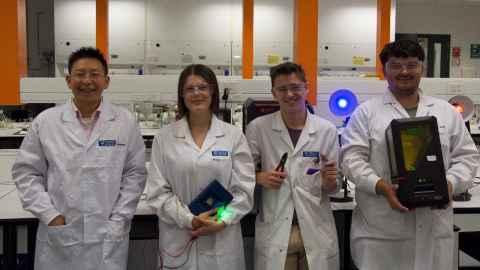Researchers print 'living', 'self-repairing' plastics
21 January 2020
'Living' and 'self-repairing' plastics could be a potential game-changer for product design and recycling.

In a world-first, researchers at the University of Auckland have demonstrated how to 3D print a ‘living’ resin, a novel technique that enables the creation of ‘living’ and ‘self-repairing’ plastics, that could be a game changer in product design and the recycling of plastics.
By ‘living’ resin the researchers mean a 3D printable material which can change its properties after it has been produced; which includes the ability to ‘grow’ in size and mass, as well as ‘self-repair’ when damaged, which adds a new dimension to the existing 3D printing process.
Honours students Chris Bainbridge, Kyle Engel and third-year undergraduate Briony Daley, under the supervision of Dr Jianyong Jin and Dr Ali Bagheri of the School of Chemical Sciences from the Faculty of Science, accomplished the world-first by producing an example of ‘living’ 3D printing using a technique known as RAFT (reversible addition fragmentation chain transfer polymerisation).
In 2018, the team came up with the idea of applying the RAFT technique to 3D printing and carried out research to perfect the process, dubbing the project The Thing after the 1982 movie.
“If 3D printing, often called additive manufacturing, is the new frontier of the fourth industrial revolution, this new technique is at the forefront of that frontier,” Dr Jin said.
Shoes 3D printed with this technique, could be
programmed to grow with the wearer.
3D printing is commonly done with a polymerisation process in an uncontrolled fashion. The technique advances 3D printing in two main ways with the big breakthrough being that the RAFT technique produces objects that Dr Jin calls ‘dormant’. Traditionally 3D printing produces inert objects that cannot change. RAFT technique objects can 'grow', 'self-repair', and new compounds can be inserted to alter their properties. The novel technique, in effect, enables the printing of 3D objects with the ability to transform after production.
Additionally, traditional 3D printed objects are ‘cured’ or set with ultraviolet light. Dr Ali Bagheri said this new technique uses visible light, such as green and red, which requires less energy and is safer. This potentially opens new opportunities in biomedical applications where it is not safe to use harmful UV light.
Kyle gives a not entirely fanciful example. Shoes 3D printed with this technique, could be programmed to grow with the wearer. Self-repairing plastic offers the potential to reduce plastic waste by removing the cost and time needed to break down plastic objects into raw material for reuse.
The researchers demonstrated the technique by producing the word RAFT as a yellow 3D printed object, and then exposing it to a growth medium. The recipe for the medium contained fluorescent compounds that were bound to the printed RAFT word to enable it to ‘grow’ and glow blue.
The team’s seminal paper was submitted for publication to the Royal Society of Chemistry ‘s flagship polymer journal “Polymer Chemistry” on 20 September, 2019 and was accepted for publication on 4 November, 2019 (DOI: 10.1039/C9PY01419E).
The University of Auckland team collaborated with researchers from the University of New South Wales and University of Melbourne, and acknowledge support from the Endeavour Fund administered by the Ministry of Business, Innovation and Employment.

Media contact
Gilbert Wong| Research Communications Manager
Mob: 021 917 942
Email: gilbert.wong@auckland.ac.nz